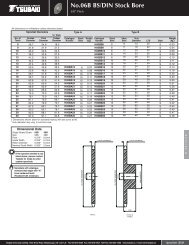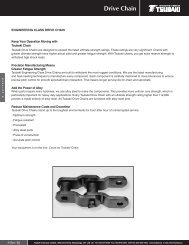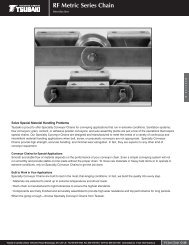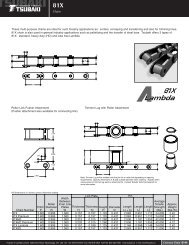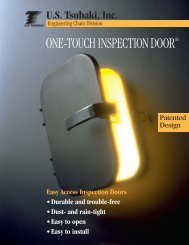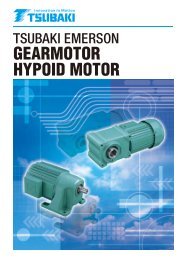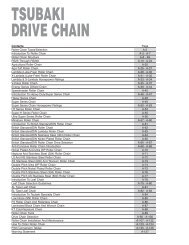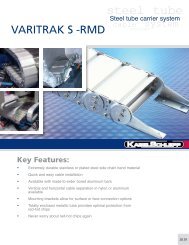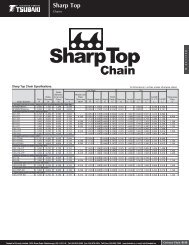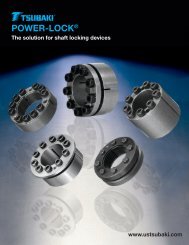DRIVE CHAINS - Tsubaki
DRIVE CHAINS - Tsubaki
DRIVE CHAINS - Tsubaki
Create successful ePaper yourself
Turn your PDF publications into a flip-book with our unique Google optimized e-Paper software.
Before Use For Safe UseStandard Roller Chains Lube-Free Roller Chains Heavy Duty Roller Chains Corrosion Resistant Roller Chains Specialty Roller Chains Accessories Selection Handling2. Service FactorsMulti-strand factorThe load borne by multi-strand roller chain is unequalacross the width of the chain, and thus it cannot beexpected that the transmission capacity will be equalto the capacity of a single-strand roller chainmultiplied by the number of strands. For this reason,the transmission capacity of multi-strand roller chainis obtained by multiplying the transmission capacityof single-strand roller chain by a multi-strand factor.Table 1: Multi-strand factorNumber ofroller chain strandsDouble strandTriple strandQuadruple strandQuintiple strandSextuple strandMulti-strand factor1.72.53.33.94.6Service factor KsThe kW ratings are based on conditions of minimalload fluctuation. Depending on the degree of loadfluctuation, it may be necessary to correct thekilowatt ratings using the service factor Ks.Use Table 2 below to determine the appropriate servicefactor based on the type of machine and the sourceof power.The design kW value is obtained by multiplying thekilowatt ratings by the service factor.Table 2: Service factor KsType ofimpactSmoothModerateLargePower sourceExample machinesBelt conveyors with little loadfluctuation, chain conveyors,centrifugal pumps, centrifugalblowers, ordinary textile machines,and ordinary machineswith little load fluctuation.Centrifugal compressors, marineengines, conveyors with moderateload fluctuation, automatic furnaces,dryers, pulverizers, generalmachine tools, compressors,general construction machines,general paper mill machines.Presses, crushers, constructionand mining equipment, vibrationmachines, oil well rigs,rubber mixers, rolls, roll gangs,general machines with reverseor large-impact loads.Motor orTurbineInternal combustion engineWithhydraulic driveWithouthydraulic drive1.0 1.0 1.21.3 1.2 1.41.5 1.4 1.7RPM factor Kn and teeth factor KzTable 3: RPM factor Kn and number of teeth factor KzRPM r/min RPM factor KnLess than 27 1.0027 or more, less than 37 1.0337 or more, less than 50 1.0750 or more, less than 70 1.1070 or more, less than 100 1.14100 or more, less than 150 1.19150 or more, less than 300 1.27300 or more, less than 500 1.34500 or more, less than 1000 1.441000 or more, less than 2000 1.542000 or more, less than 4000 1.65Figure 1: Shock factor KR =Number of teeth Teeth factor Kz9 or more, less than 12 1.1612 or more, less than 15 1.1415 or more, less than 18 1.1218 or more, less than 24 1.1024 or more, less than 30 1.0830 or more, less than 38 1.0638 or more, less than 47 1.0447 or more, less than 60 1.0260 or higher 1.00Shock factor KThis coefficient is determined by the ratio of themoments of inertia between the prime mover and thedriven machine (rate of I, GD 2 ), and the amount ofbacklash in the transmission device.When the inertia ratio R is greater than 10, use R = 10.When the inertia ratio R is less than 0.2, use R = 0.2.If I or GD 2of the prime mover or driven machine isunknown, use the value of R in Figure 1.Shock factor KTransmission Lifting work ConveyorMillHoistRoll gangCrane travel and ShuttleInertia ratio RFlywheelTable 4: Imbalance load factor Kudevice has backlashLoad inertia converted to motor shaft inertiaMotor inertiaTransmission device has no backlash caused by slack in chain,etc.Imbalance load factor KuWhen carrying out shuttle traction and lifting with twochains, or four chains for shuttle drive and lifting, thechain tension is not uniform. This must be accounted forby multiplying the following imbalance load coefficientKu to adjust the left-and-right load imbalance.Examle: For four lifting strands, the imbalance loadfactor for one strand Ku= 0.6 0.6 = 0.362 lifting strands4 lifting strands0.60.36133



